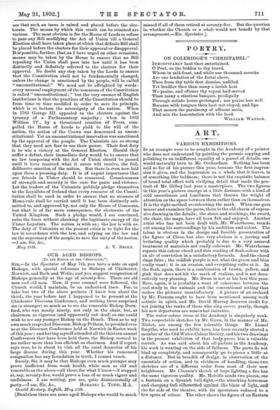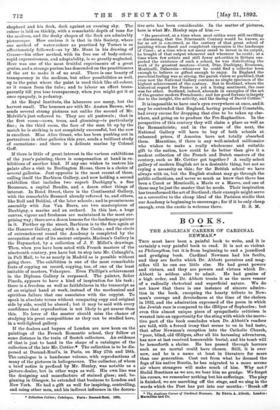ART.
VARIOUS EXHIBITIONS.
IF an example were to be sought in the Academy of a painter who does not understand by painting the prosaic copying and polishing to an indifferent equality of a parcel of details, one would naturally turn to Mr. Orchardson. Nothing has been said so far of his picture this year, because the first impres- sion it gives, and the impression as a whole that it leaves, is of something like baldness; there is not the exquisite balance of broad total effect with vivifying detail that made the por- trait of Mr. Gilbey last year a masterpiece. The two figures in this year's picture emerge at a little distance with a kind of cold, smoothness and loneliness that throws the weight of attention on the space between them rather than on themselves.
It is the right method overshooting the mark. When one goes nearer and examines the parts, there is the old charm of expres- sive drawing in the details; the shoes and stockings, the sword, the chair, the maps, have all been felt and enjoyed. Another artist who has not been dealt with, Mr. Waterhouse, stands
out among his surroundings by his ambition and talent. The talent is obvious in the design and forcible presentation of the figure of Circe, but also very obvious is a jarring and irritating quality which probably is due to a very assured treatment of materials not really coherent. Mr. Waterhouse repeats this colour chord and this reading of flesh-colour with an air of conviction in a satisfactory formula. And the chord rings false ; the reddish purple is not what the green and blue really want ; it is an evasion, and everything sulks at it. In the flesh, again, there is a combination of brown, yellow, and pink that does not hit the mark of realism, and is not deco- ratively very pleasing. Mr. Swan is not at his best this year. Here, again, it is probably a want of coherence between the real study in the animals and the conventional setting that makes the pictures unsatisfactory. A picture of an orchard by Mr. Parsons ought to have been mentioned among work artistic in spirit, and Mr. David Murray deserves credit for not joining the ranks of those who sing encore yearly, though his new departures are somewhat imitative.
The water-colour room at the Academy is singularly weak. Two respectable sketches by Mr. Gunn, in the manner of Mr. Nisbet, are among the few tolerable things. Mr. Lionel Smythe, who used to exhibit here, has been recently elected a member of the Old Water-Colour Society, and his two drawings in the present exhibition of that body prove him a valuable recruit. As was said about his oil-picture in the Academy, his work is wanting on the side of fullness. The parts do not bind up completely, and consequently go to pieces a little at a distance. But in breadth of design, in observation of the essentials of action, and in vividness of handling, those two sketches are of a different order from most of their new neighbours. Mr. Clausen's sketch of boys lighting a fire has the same vigorous quality. Mr. Melville sends two pieces, one a fantasia on a Spanish bull-fight,—the attacking horseman and charging bull silhouetted against the blaze of light, and the far side of the theatre, with its spectators reduced to a few spots of colour. The other shows the figure of an Eastern
shepherd and his flock, dark against an evening sky. The colour is laid on thickly, with a remarkable depth of tone for the medium, and the dusky shapes of the flock are admirably picturesque. How curious it is that in this Society, where one method of water-colour as practised by Turner is so affectionately followed—as by Mr. Hunt in his drawing of Grasse—his other method, with its free use of body-colour, rapid expressiveness, and adaptability, is so greatly neglected. Here was one of the most fruitful experiments of a great genius, and a strange purism has descended on the practitioners of the art to make it of no avail. There is one beauty of transparency in the medium, but other possibilities as well, up to the point where the paint is used thick like oil-colour, as it comes from the tube; and to labour an effect trans- parently till you lose transparency, when you might get it at once opaquely, is pedantry.
At the Royal Institute, the labourers are many, but the harvest small. The honours are with Mr. Austen Brown, who sends several strong pictures not unlike the second of Mr. Melville's just referred to. They are all pastorals; that in the first room—cows, trees, and gloaming—is particularly fine ; in the third room, the face of the man lit up by the match he is striking is not completely successful, but the cow is excellent. Miss Alice Grant, who has been pushing out in portraiture in other galleries this year, sends a brilliant study of carnations : and there is a delicate marine by Colonel Goff.
If there is little of great interest in the various exhibitions of the year's painting, there is oompensation at hand in ex- hibitions of another kind. If any one wishes to restore his palate after a visit to Burlington House, there is a choice of several galleries. Just opposite is the most recent of these, calling itself the Barbizon Gallery, and now holding a second exhibition that includes two superb Daubigny's, a fine Rousseau, a capital Boudin, and a dozen other things of interest. In Bond Street, there is the Continental Gallery, with the remarkable Besnard already referred to, and others, like Roll and Boldini, of the later schools ; and in promiscuous assembly with Jan Van Beers, are two masterpieces of Danbigny, a marine and an orchard. In this last, a huge canvas, vigour and freshness are maintained in the most sur- prising way; there are a dozen lessons for the landscape-painter in it. Further up the street, Barbizon is to the fore again at the Hanover Gallery, along with a fine Cazin ; and the circle of entrenchment round the Academy is completed by the occupation of one of its ancient outposts, Maclean's Gallery in the Haymarket, by a collection of J. F. Millet's drawings. Then, when you have been sated with French masters of the nineteenth century, you have but to step into Mr. Colnaghi's, in Pall Mall, to be as nearly in Madrid as is possible without going there. The exhibition is one of the most remarkable feats of copying on record, copying, too, of one of the least imitable of masters, Velazquez. Even Phillips's achievement in the Diploma Gallery is surpassed. The painter, Seiior Pineda, appears to have a kind of inspiration for his task ; there is a freedom as well as faithfulness in the transcript as of an original hand at work, instead of the mechanical and spiritless failure that one associates with the copyist. To speak in absolute terms without comparing copy and original side by side, would be absurd ; but it may be said with every confidence that reproduction is not likely to get nearer than this. No lover of the master should miss the chance of studying his great compositions as they can be studied here, in a well-lighted gallery.
If the dealers and buyers of London are now keen on the paintings of the French Romantic school, they follow at some distance in the train of Scotch collectors. An evidence of that is just to hand in the shape of a catalogue of the collection of the late Mr. Cottier.* The collection is to be dis- persed at Durand-Ruel's, in Paris, on May 27th and 28th. The catalogue is a handsome volume, with reproductions of many of the pictures in heliograv-ure. The collector, of whom a brief notice is prefixed by Mr. Henley, was notable as a picture-dealer, but in other ways as welL His own line was the designing and manufacture of stained glass ; and, be- ginning in Glasgow, he extended that business to London and New York. He had a gift as well for inspiring, controlling, and using other men, and his indirect influence in the dee.om-
• Collection Cattier; Catalogue, Paris Durand-Bail 1892.
tire arts has been considerable. In the matter of pictures,. here is what Mr. Henley says of him :—
" He perceived, at a time when most critics were still cavilling or discussing, that the Nineteenth Century would be known, so- far as art is concerned, as the century of that great school of painting whose finest and completest expression is the landscape of Corot; at a time when not many cared to invest in its output, he bought of that output whenever and wherever he could ; at a time when few artists and still fewer art-critics in Britain sus- pected the existence of such a school, he was distributing the work of its greatest masters—Corot, Diaz, Daubigny, Rousseau,
Delacroix—whenever he could find a collector keeir enough to believe or gifted enough to enjoy. In England the parochial feeling was so strong, the parish vision so purblind, that. evennow the National Gallery contains no single specimen of the highest achievement of the century. But in Scotland, where the historical regard for France is yet a living sentiment, the case was far other. Scotland, indeed, abounds in examples of the art of the greater modern Frenchmen; and her good fortune is largely due to the insight, the activity, and the daring of David Cottier.'
It is impossible to have one's eyes everywhere at once, and it. may be contended that England, having produced Constable,. had every excuse for dropping that clue to be taken up else-
where, and going on to produce the Pre-Raphaelites. In the perspective of this century they will claim a place as well as the Romanticists; and in the course of the next, the National Gallery will have to buy of both schools at enhanced prices, if America have not totally absorbed them. Meantime, if there is any well-minded millionaire who wishes to make a really wholesome and suitable gift to the nation, how could he do better than give it & modest collection of the French and Dutch masters of the century, such as Mr. Cottier got together ? A really select gallery of modern English art is a desirable thing, but not so- crying a necessity as this ; for the British school we have always with us, but the English student may go through the public collections, and never so much as know that there haa been a Corot or Montioelli, a Mans or a Mauve, and one of these may be just the master that he needs. Their inspiration has transformed the art of Scotland; their example might serve as a corrective to the cheap ideal of the Parisian studio that.
our Academy is beginning to encourage ; for if it be only cheap.
enough, even the exotic is welcome there. D. S. M.



































 Previous page
Previous page